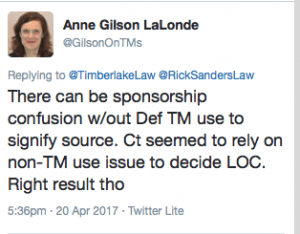It’s Derby time! I don’t live in Louisville, but I used to spend a lot of time there for work, and when I was in college at Vanderbilt University, the Kentucky Derby would always be the Saturday right after finals ended and was only a two hour drive up I-65. As poor college kids we drank watered down Mint Juleps and got soaked and muddy in the infield and of course never saw a horse, but it was always a great time. Now, I mostly just watch it on TV and pick a horse based on whether Bob Baffert has trained it, since you can’t bet on the jockey Bill Shoemaker anymore, which is what my grandfather always said you should do.
The enormous business of horse-racing and all the merchandising that goes along with it causes horse tracks to occasionally get aggressive with their trademark ownership. Courts in the Sixth Circuit sees their fair share of these cases, since Central Kentucky is Horse Country, and has been Horseracing Country since the late 19th Century (thanks to a crackdown on gambling in New York brought about by the women of the Progressive Movement.)
The latest case to reach the Sixth Circuit, Oaklawn Jockey Club, Inc. et. al. v. Kentucky Downs, LLC et. al (No. 16-15582) (April 19, 2017) involves gambling venues where patrons bet on historical races. Patrons place their bets and a computer-generated video “replay” of the race is played. The video shows only the order of the finish, and does not use any visual elements of the original racetrack. It does, however, identify the name of the track where the race took place, the date, the race number and the race ID. This display of the track name caused Oaklawn Jockey Club, Churchill Downs, and a whole host of other track owners to claim trademark infringement. The case was dismissed at the District Court for failure to state a claim, and affirmed last week at the Sixth Circuit in an unpublished opinion, because “plaintiffs failed to adequately plead that defendant’s use of Plaintiff’s trademarks was likely to cause consumer confusion.”
The Sixth Circuit has an unusual threshold for maintaining infringement cases – unlike any other circuit, it requires an initial showing that “Defendants are using Plaintiff’s trademark to identify the source of Defendant’s product” before it will employ the eight-factor likelihood of confusion test. The approach has been criticized by McCarthy as lacking any “statutory or case law authority.”[1] The line of cases started in 2003 in a case where defendants had sold plaintiff’s LAP TRAVELLER laptop desk for cars (hopefully stationary ones), and used the LAPTRAVELLER word in its URL. [2] When Defendant was forced to stop selling the LAP TRAVELLER desk, it never changed the URL. The Court found that the use of the mark in the middle of the URL, when all the products on the site were clearly marked with other names, was not “use in a trademark sense” and therefore not actionable. Later in the opinion, the Court had to go and say that this kind of use in a URL was only “unlikely” to violate federal law, so no blanket rule there. In the next case involving the nature of the defendant’s use[3], the Court first referred to the Interactive Products decision, indicated that this threshold question of whether the defendant is using the mark to identify their goods is in fact a thing in the Sixth Circuit, and then said that because “there was no likelihood of confusion as to the source of the products”, it didn’t even need to get into the eight-factor likelihood of confusion test.
If there’s no likelihood of confusion as to source, haven’t we pretty much answered the question the eight-factor test is trying to answer anyway?
In this latest foray, the Court once again said that this threshold question exists, and then proceeded to find that the “[The Defendants’] depictions were sufficiently different from the Track Owner’s product – live horse racing at their venues – that the minimal use of the trademarks, preceded by the world LOCATION, would not confuse consumers into believing the videos were provided by Plaintiffs.” In this case, they were absolutely right, of course, but didn’t they just answer the question of the relatedness of the goods, one of the likelihood of confusion factors?
My partner Rick Sanders discussed this case on Twitter the other day, leading to the following response from the well-known Anne Gilson LaLonde, who summed up in 140 characters what I just took 780 words to say.

Yes, it was the right result, but I wish the 6th Circuit would quit doing that.
[1] 4 McCarthy on Trademarks and Unfair Competition §23.11.40 (4th ed.)
[2] Interactive Prods. Corp. v. a2z Mobile Office Solutions, Inc., 326 F.3d 687 (6th Cir. 2003)
[3] Hensley Mfg. v ProPride, Inc., 549 F.3d 603 (6th Cir. 2009)


